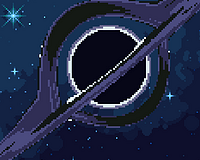Devlog: Adding Asteroids and Polishing the Universe

Posted June 21, 2025 by BligusFalantis
Devlog: Adding Asteroids and Polishing the Universe
This session was packed with new features and a ton of quality-of-life improvements that make the game feel more interactive and polished. Here’s a breakdown of what we accomplished.
New Core Feature: Asteroid Mining
The biggest addition is a brand-new asteroid spawning system. This gives players an active way to gather resources by clicking on objects moving across the screen.
- Asteroid Manager: We created a new singleton,
AsteroidManager, responsible for spawning asteroids. It randomly selects an asteroid type, determines a starting position just off-screen, and gives it a random trajectory and speed. - Asteroid Entity: A new
asteroid.tscnscene andasteroid.gdscript were built. Each asteroid has its own health, moves across the screen, and can be clicked. - Click & Collect: Clicking an asteroid damages it and provides the player with a small number of resources. If the main space station’s storage is full, these resources are automatically sold for gold, providing a useful overflow mechanic.
- Feedback System: Clicks are accompanied by a pulse effect, and floating text numbers appear at the asteroid’s location (in white) and at the space station (in green) to show the resources gained.
Polishing the Payoff: The Perfect Asteroid Explosion
Getting the destruction effect just right took a few iterations, but the result is fantastic. When an asteroid’s health reaches zero:
- The explosion animation (currently a black hole) plays.
- A
Tweensimultaneously triggers three effects on the visual node:- A quick, intense shake effect.
- A smooth fade-out to transparency.
- A scaling effect, shrinking the asteroid down to nothing.
- Once the animation is complete, the node is removed from the scene.
Major Quality of Life & Control Upgrades
We made significant changes to how the player controls the main space station to make it more intuitive and robust.
- Physics-Based Movement: The
SpaceStationwas converted from aNode2Dto aCharacterBody2D. Planets and the sun were converted toStaticBody2Ds. This introduces real physics, preventing the station from flying through celestial bodies. The movement logic was updated to usevelocityandmove_and_slide(). - Refined Mouse Controls: The biggest UX improvement! Station movement is now bound to the right mouse button. This completely separates the “move” action from the “interact/click” action (left mouse button), resolving all conflicts where clicking on a planet or asteroid would also move the station.
- Keyboard Controls: Players can now also pilot the station directly using the arrow keys (
ui_up,ui_down,ui_left,ui_right).
UI/UX Refinements
A lot of work went into making the UI clearer and more visually consistent.
- Manager Cards:
- Logic Fix: The “Remove” button now correctly only appears on a manager card if that manager is currently assigned to a planet.
- Visual Polish: The card’s border is now colored according to the manager’s rarity (Common, Uncommon, Rare, Epic), matching the color of their name for a cohesive look. This was also applied to the manager upgrade cards in the Research panel.
- Readability: The bonus text on manager cards now uses line breaks instead of commas, and the font size was adjusted for better readability.
- Planet Panel:
- Live Editing: The
planet.gdscript is now a@toolscript, allowing for real-time adjustments in the editor. We exposed thelocked_colorproperty, so we can tweak how dark a locked planet appears directly in the Inspector. - Consistent Previews: The preview for a locked planet inside its panel now perfectly mirrors its appearance in the main game scene, showing the darkened planet with a large question mark over it. We also exposed offset properties to fine-tune the positioning of these elements in the editor.
- Live Editing: The
This session was incredibly productive. The new asteroid system adds a fun layer of interaction, and the numerous control and UI fixes make the entire experience feel much more professional and enjoyable.
Files
- exports1.zip 18 MB65 days ago